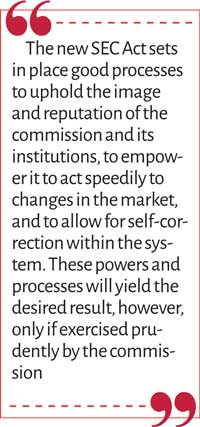Friday Jan 02, 2026
Friday Jan 02, 2026
Wednesday, 9 March 2022 00:00 - - {{hitsCtrl.values.hits}}

Strong institutions inspire public confidence. In order to attract investors to capital markets, it is essential that the regulatory authority inspire the confidence of present and potential investors. Two factors that contribute to confidence in institutions are its personnel, and its institutional processes. In this piece, I will explore three categories of provisions in the new SEC Act which strengthen the governance structures of the commission. These are to do with (a) image; (b) speed and efficacy; and (c) self-correction. This is not intended as an exhaustive account of each category of provisions, only a highlighting of some salient features.
factors that contribute to confidence in institutions are its personnel, and its institutional processes. In this piece, I will explore three categories of provisions in the new SEC Act which strengthen the governance structures of the commission. These are to do with (a) image; (b) speed and efficacy; and (c) self-correction. This is not intended as an exhaustive account of each category of provisions, only a highlighting of some salient features.
Image
The wide discretionary powers afforded to the commission were discussed in the previous article. I suggested there, that because of the extent of these powers, investor confidence would be greatly influenced by the particular composition of the commission. In other words, faith in the commission’s members will inspire faith in the commission itself. If investors trust that the commission will exercise its discretionary powers judiciously and with appropriate restraint, then the capital markets will thrive. If, however, it oversteps its bounds, or fails to take action where necessary, or to act impartially amongst different stakeholders in the market, investors are likely to be vary of entering the market, and may do so only if they are able to make other arrangements to secure their interests.
Section 5 of the Act sets out the composition of the commission:
•6 persons with “professional expertise and standing” in matters relating to the securities market: particularly professionals from the fields of law, finance, accounting, economics, banking or business, of whom five are from the private sector;
•2 nominated members: a Deputy Secretary to the Treasury and a Deputy Governor of the Central Bank;
•2 ex-officio members: the Registrar General of Companies, and the President of the Institute of Chartered Accountants of Sri Lanka.
In appointing these persons, the Minister must consider the person’s “integrity and standing”, and possible conflicts of interests.
Section 6 expands this focus on conflicts of interests, and requires commission members to make a declaration of any conflicts of interests they may have when appointed. The close scrutiny of conflicts of interests in this law marks an important change in our culture of governance. Even in the developed world, serious concerns are being raised about the manner in which governmental regulatory roles are being captured by big corporates with vested interests. This takes place under the guise of ‘consulting industry experts’ or ‘incorporating the feedback of stakeholders’, with little regard to how such advice may be tailored to protect the interests of the persons being sought to be regulated. By requiring members of the commission to declare potential conflicts of interests, the Act promotes transparency and reduces the potential for vested interests to capture this crucial regulatory body.
Having disclosed such interests, the Act provides that, where a member is directly or indirectly interested in a decision on any matter taken by the commission, he is required to disclose such interest at the relevant meeting. This is then recorded in the minutes, and that member cannot not take part in the deliberation or decision on that matter, and must in fact withdraw from the meeting for the duration of the deliberation (s. 13). In this way, at least in theory, the Act seeks to reduce the possibility for conflicts and biases in the commission’s decision-making.
interested in a decision on any matter taken by the commission, he is required to disclose such interest at the relevant meeting. This is then recorded in the minutes, and that member cannot not take part in the deliberation or decision on that matter, and must in fact withdraw from the meeting for the duration of the deliberation (s. 13). In this way, at least in theory, the Act seeks to reduce the possibility for conflicts and biases in the commission’s decision-making.
These provisions may be sufficient to shut out the conflicts of interests of individual commissioners. However, there are concealed conflicts that may emerge from the scheme of this Act. For instance, the commission exercises control over three funds: the Cess Fund, the Fund of the Commission, and the Compensation Fund. It may invest monies in these funds in a manner it determines (ss. 156(3), 157(3), 158(3)). If it also invests in securities traded on exchanges (and nothing in the Act suggests that it may not do so), then adequate precautions will have to be taken to ensure that the commission’s own financial interests do not conflict with its regulatory role. For instance, if the commission has a large shareholding in Company A (whether directly, or indirectly through a Unit Trust, for instance), there will be a conflict of interests if it has to take a decision on Company A, whether of a penal nature or otherwise. Appropriate guidelines will have to be prepared to regulate decision-making in such situations, or to specify restrictions in how the commission may invest these monies. For the present time, this writer learns that the commission’s funds are not invested in the stock market, and so this concern does not arise.
The theme of sound structures and processes runs throughout the Act, and extends to other market stakeholders. For instance, conflicts of interests are scrutinised where a licensed exchange seeks to list its own securities on its exchange (s. 31(3)(a)), and in the appointment of directors to market institutions (s. 68(2)(v)). Suitable “governance structures” are required of market institutions (s. 26(3)(c)), (s. 37(3)(a)), which must report annually on their corporate governance policy (s. 73(1)(a)). The nature of these governance structures, and how the commission will determine if they are adequate to the role of each institution will have to be developed and put in writing over time. Furthermore, it is also empowered to frame rules on the “fit and proper” criteria (s. 183(1)(j)) which will apply to directors and CEOs of all listed public companies (s. 89(2)).
All these provisions serve to strengthen the public image and reputation of the commission and the institutions it seeks to regulate. Thereby, the first step to inspiring investor confidence is secured.
Speed and efficacy
Presenting a good public face may inspire investor confidence in the commission, but in order to retain it, the commission will have to prove its effectiveness in performing its roles. In this regard, it is essential that there be processes to ensure that it can act swiftly to respond to the very dynamic environment of capital markets. The new SEC Act facilitates this through a number of provisions.
First, section 64 deals with the rules of different market institutions (exchanges, clearing houses and central depositories), which require the approval of the commission. When changes are proposed by market institutions, the commission is required to hear the relevant institution and make a decision on the amendments within 90 days (ss. 64(4), (5)). Where it fails to respond with a decision in time, the proposed amendments will take effect on the expiration of that period. This forces the commission to develop mechanisms to expedite such decisions, and prevents the possibility of crucial changes being subjected to the bureaucratic delays which often characterise other public institutions. The commission, however, may “at any time” amend the rules of any market institution, and such amendments take force with immediate effect, or on the date specified by it (s. 64(9)). This is a very broad power which must be exercised conservatively, but its existence allows the commission to act with decisiveness and haste in the event an urgent change to the rules is required.
with immediate effect, or on the date specified by it (s. 64(9)). This is a very broad power which must be exercised conservatively, but its existence allows the commission to act with decisiveness and haste in the event an urgent change to the rules is required.
Second, the commission has significant powers to issue and/or obtain different types of orders to protect the interests of investors and other market stakeholders. These include ‘stop orders’ in relation to a potentially false or misleading prospectus or similar document prior to the public issue of securities (s. 83), which may even be issued as an interim order without giving an affected party the opportunity of being heard (s. 83(3)). In terms of section 167, the commission may also issue ‘freezing orders’ to prohibit a person from disposing of assets related to an inquiry, or from entering into “any transaction or a class of transactions” as may be determined. This is a very wide power which operates immediately, and continues for seven market days, and can be extended thereafter if the commission applies to the Commercial High Court to confirm the order. Finally, section 180 gives it the power to obtain orders of court on a raft of matters, which include:
A person may face penalties for defying the directives of the commission, but once a court order is obtained, such defiance can continue only under the peril of contempt of court. This is therefore a powerful tool by which the commission can secure compliance with its directives. These orders too may be obtained ex parte at the first instance (s. 180(2)).
Third, given how complex securities-related offences are, the commission needs the freedom to conduct investigations discreetly, and should not be unduly compromised by reporting requirements. Under section 173, the Minister may require the commission to furnish information. However, the proviso permits the commission to withhold information deemed confidential, on the grounds that it would gravely prejudice an ongoing investigation, or prejudice the prevention or detection of an offence, or expose the identity of a confidential source of information (for example, the identity of a whistleblower, or the fact that one is working with the commission). This provision thus reduces the likelihood of a leak of sensitive information which may compromise investigative functions. Furthermore, it demonstrates that the commission is given some insulation and independence from the Minister, and that it must act first and foremost towards achieving its objectives, and not in mere deference to governmental hierarchy.
Thus, in approving and making rules, securing orders to respond swiftly to situations that may occur in the markets, and in carrying out effective investigations, the new Act galvanises the commission to act with speed and decisiveness.
Self-correction
Strong institutions employ internal checks to strengthen its processes, in addition to external accountability. The new Act has several provisions which embrace this approach.
Section 78, which appears at the end of Part II on Markets and Market Institutions, confers the commission with the power to review its own decisions. Any person aggrieved by a decision may apply to the commission within 30 days of being notified of the same, and the commission is required to communicate its decision within 90 days thereof. This offers a less costly and less contentious alternative to invoking the jurisdiction of the Court of Appeal (under section 186). For this provision to be meaningful, the commission will have to establish mechanisms to ensure that the process of review may yield a different result to the original decision: for instance, by obtaining the input of an independent or expert opinion at the second consideration.
The most powerful mechanism for self-correction is the Act’s provisions on whistleblowers (s. 172). Under this section, an employer is not permitted to discharge, terminate, demote, or cause harassment to ‘a person in employment’ on account of “having provided information to the Commission concerning violations or potential violations” of the Act and other rules. In addition to this protection, the commission also has the power to grant a reward to whistleblowers who first provide information which leads to a successful prosecution or sanction (s. 172(4)). In this way, potential whistleblowers are reassured that they will not face adverse consequences from their places of work, and are presented with the carrot of a potential reward, and the stick of punishment or sanction in the event they are implicated in the relevant misconduct or violation.
This provision is progressive to the extent that it seeks to enlist persons within the market to help uphold the rules. However, it may fail to address the realities around whistleblowing. The significant cases – those of greatest interest to the commission - are likely to involve grand schemes of market misconduct. These are likely to seriously damage the reputation of the companies involved, if not ruining them altogether. Therefore, merely ensuring that potential whistleblowers in these schemes will not face reprisals from the companies themselves is insufficient - there may not be much left after the investigation or prosecution is complete. Even if the company survives, the whistleblower is not likely to want to continue in such employment, as the entire workplace may become a hostile to him. Potential whistleblowers are often torn between their conscience to do what is right, and the practical realities of loss of income and the ensuing difficulty to support family or lifestyle. Therefore, a more systematic scheme may be to ensure a ‘soft-landing’ for whistleblowers – perhaps in the form of suitable compensation for a reasonable period of time in order to allow the whistleblower to find alternate employment. This would be much more practical than the mere possibility of a reward, and more likely to tip the internal calculations of potential whistleblowers towards coming forward.
Conclusion
The new SEC Act sets in place good processes to uphold the image and reputation of the commission and its institutions, to empower it to act speedily to changes in the market, and to allow for self-correction within the system. These powers and processes will yield the desired result, however, only if exercised prudently by the commission.
(The writer is an Attorney-at-Law, and can be reached for feedback at [email protected].)